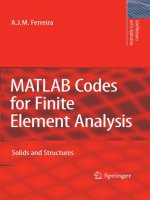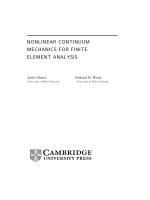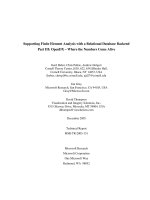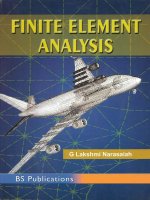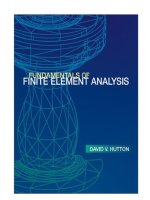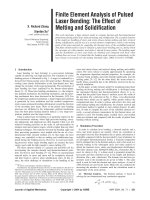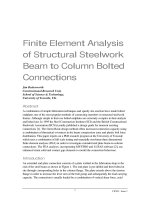Random finite element analysis on cement treated soil layer
Bạn đang xem bản rút gọn của tài liệu. Xem và tải ngay bản đầy đủ của tài liệu tại đây (17.94 MB, 330 trang )
RANDOM FINITE ELEMENT ANALYSIS ON
CEMENT-TREATED SOIL LAYER
LIU YONG
(M. Eng., HUST; B. Sci., CSU)
A THESIS SUBMITTED
FOR THE DEGREE OF DOCTOR OF PHILOSOPHY
DEPARTMENT OF CIVIL AND ENVIRONMENTAL ENGINEERING
NATIONAL UNIVERSITY OF SINGAPORE
2013
i
DECLARATION
iii
ACKNOWLEDGEMENTS
The author feels most indebted to his supervisors Professor Lee Fook Hou and Professor
Quek Ser Tong for their invaluable advice, comments, patience and support. Working with
them has been rewarding and enjoyable. Through many pleasant conversations and
discussions with them, I have definitely leant many things beyond academic matters.
Grateful acknowledgement is expressed to Professor Zheng Jun-Jie (School of Civil &
Mechanic Engineering, Huazhong University of Science & Technology, Wuhan, China) for
his invaluable encouragement and academic instructions throughout the author’s pursuing of
his master and PhD degrees.
Grateful acknowledgement is expressed to Assistant Professor Goh Siang Huat, Professor
Phoon Kok Kwang and Associate Professor Tan Siew Ann for their academic instructions.
Grateful acknowledgement is also expressed to Dr. Xiao Huawen, Dr. Chen Xi, Dr. Cheng
Yong-gang, Dr. Zhao Ben, Dr. Chen Jian, Dr. Yi Jiang-tao, Dr. Yang Hai-bo, Ms. Saw Ay-
lee, Ms. Chen Zong-rui, Ms. Li Yu-ping and Mr. Pan Yu-tao for their technical supports.
The Monte-Carlo simulations in this study were mainly conducted on two platforms. One is
the High Performance Computing (HPC) system in Computer Centre at National University
of Singapore, and the other one is the Educational and Information Technology (EIT)
laboratory in the Department of Civil and Environmental Engineering at National University
of Singapore. Grateful acknowledgement is expressed to all staff in these two systems for
their help.
The financial support from the National University of Singapore is gratefully acknowledged.
iv
v
TABLE OF CONTENTS
DECLARATION i
ACKNOWLEDGEMENTS iii
TABLE OF CONTENTS v
SUMMARY ix
LIST OF TABLES xiii
LIST OF FIGURES xiv
LIST OF SYMBOLS xxi
Chapter 1 Introduction 1
1.1 Use of Cement-Treated Soil Layers in Excavations 1
1.2 Deep Mixing and Jet Grouting 3
1.3 Heterogeneity of Cement-Treated Ground 4
1.4 Objectives and Scope of Study 6
1.5 Organisation of Thesis 9
Chapter 2 Literature Review 13
2.1 Introduction 13
2.2 Heterogeneity of Cement-treated Soils 13
2.2.1 Deterministic Trend 14
2.2.2 Stochastic Fluctuation 15
2.2.3 Uncertainties in Column Positioning 18
2.3 Existing Methods Dealing with Heterogeneity of Cement-treated Soils 19
2.3.1 Probabilistic Evaluation 19
2.3.2 Finite Difference Method Incorporating Heterogeneity 20
2.3.3 Numerical Limit Analyses 21
2.3.4 Finite Element Method 21
2.3.5 Two-part Deterministic Method 22
2.4 Finite Element Methods Dealing with Heterogeneity 23
2.4.1 Direct Monte-Carlo Simulation 23
2.4.2 Stochastic/Random Finite Element Method 24
vi
2.5 Outstanding Issues 26
Chapter 3 Generation of Random Fields 43
3.1 Introduction 43
3.2 Linear Estimation Method 45
3.3 Modified Linear Estimation Method for Normal Fields 47
3.3.1 Two-dimensional Unit-variate Normal Fields 47
3.3.2 n-dimensional m-variate Normal Fields 51
3.3.3 Normality of Property Field 54
3.3.4 Cross-correlation of Property Field 54
3.3.5 Stationarity of Property Field 55
3.3.6 Ergodicity of Property Field 58
3.3.7 Sensitivity Study on Randomized Rotation 59
3.3.8 Sensitivity Study on Randomized Translation 60
3.3.9 Normal Fields in Cylindrical Polar Coordinate System 60
3.4 Generation of Underlying Normal Fields for Non-normal Fields 62
3.4.1 Definition of Translation Fields 62
3.4.2 Translation Lognormal Field 63
3.4.3 Translation Beta Field 64
3.5 Verifications of Proposed Method via Monte-Carlo Simulations 71
3.6 Validations 73
3.7 Summary 79
Chapter 4 Spatial Variation of Stiffness and Strength 101
4.1 Introduction 101
4.2 Radial Deterministic Trends 103
4.3 Marginal Probability Density Function 104
4.4 Statistical Characteristics of Strength 108
4.4.1 Prediction from Experimental Work 108
4.4.2 Field Data 112
4.5 Autocorrelation Structure 112
4.5.1 Evaluation from Field Data 113
4.5.2 Evaluation from Experimental Data 114
4.5.3 Evaluation from Local Averaging Method 115
vii
4.6 Correlation between Stiffness and Strength 118
4.7 Summary 118
Chapter 5 Deterministic Finite Element Analysis 139
5.1 Introduction 139
5.2 Problem Description, Model Setup and Verification 140
5.2.1 Problem Description 140
5.2.2 Material Assignment and Model Setup 141
5.2.3 Model Verification 142
5.2.4 Presentation of Calculation Results 143
5.3 Parametric Studies 144
5.3.1 Strain-softening Effects of Cement-treated Soils 145
5.3.2 Layout Patterns of Column Arrangement 148
5.3.3 Radial Trend in Stiffness and Strength 149
5.3.4 Overlapping Distance 150
5.3.5 Overburden Pressures 151
5.4 Summary 152
Chapter 6 Random Finite Element Analysis 171
6.1 Introduction 171
6.2 Method Verification Using a Two-dimensional Problem 172
6.2.1 Problem Statement 172
6.2.2 Results 173
6.2.3 Discussions 174
6.3 Method Verification Using a Three-dimensional Problem 174
6.3.1 Problem Statement 175
6.3.2 Results 176
6.3.3 Comparison of Results 177
6.4 Improved Soil Layer 178
6.4.1 Three-dimensional Bivariate Cylindrical Random Fields 178
6.4.2 Parameter Choices 181
6.4.3 Monte-Carlo Simulation Results 183
6.5 Parametric Studies 185
6.5.1 Strain-Softening Effects and Boundary Conditions 186
viii
6.5.2 Model Size 187
6.5.3 Coefficient of Variation and Skewness of Cement-treated soils 190
6.5.4 Influence of Autocorrelation Length 192
6.5.5 Cross-correlation between UCS and Elastic Modulus 193
6.5.6 Radial Variation in Strength 194
6.5.7 Positioning Error 196
6.5.8 Autocorrelation Lengths of Positioning Error 197
6.5.9 Poisson’s Ratio 201
6.6 Practical Aspects 201
6.6.1 Current Design Methodology 201
6.6.2 Engineering Implications of Findings 203
6.6.3 Proposed Design Guidelines 206
6.6.4 Discussion on Validation of Proposed Design Guidelines 209
6.6.5 An Illustrative Example 210
Chapter 7 Conclusions and Recommendations 255
7.1 Conclusions 255
7.2 Recommendations for Future Work 258
References 261
Appendix A Derivation of Autocorrelation Function in Two-
Dimensional Space of Modified Linear Estimation Method 273
Appendix B Estimating Bounds of Beta Distribution 281
Appendix C Lower Bound for Correlation of Translation Processes 287
Appendix D Mesh Size Effect 293
Appendix E
Standard Error in Monte-Carlo Simulation Results 301
ix
SUMMARY
A layer of improved soil consisting of short overlapping soil-cement columns that are formed
by deep mixing method or jet grouting is often used to stabilize an excavation in soft soil
(e.g., Tanaka, 1993; O’Rourke and McGinn, 2006). The improved soil layer is often installed
prior to excavation and below the excavation formation level. It resists lateral compression
from the inwards moving retaining wall as excavation proceeds. Thus, rational evaluations of
lateral bearing capacity and stiffness of the slab as a mass are of practical importance in an
excavation.
In this thesis, spatial variability of cement-treated soils is investigated and its influences on
the lateral mass behaviour of the layer are analyzed by numerical simulations. The spatial
variability is resolved into three categories: (1) a deterministic trend in strength along the
radial direction, which is described by a deterministic function of radial distance, (2) a
stochastic fluctuation portion around the deterministic trend, which is simulated by three-
dimensional random fields and (3) positioning error in installation columns, which refers to
the deviation of column centres from their designed positions due to the off-verticality in pile
drilling.
In this study, a modified linear estimation method has been proposed to generate normal
random fields. The proposed method has been shown to be able to generate a large multi-
dimensional property field that is both normally distributed and weakly stationary. The
simulated property field is also shown to be ergodic both in the mean and correlation as long
as the property field has a finite autocorrelation length along each direction. The proposed
method can also be extended to a cylindrical field with orthogonal stationary. For a
x
cylindrical field, the simulated autocorrelation function along the circumferential direction is
a monotonically decreasing function in the interval [0, π].
The spatial variability of cement-treated soils is examined based on field data, experimental
data and existing publications. The ranges of some statistical parameters are assessed: (a) The
coefficient of variation of unconfined compressive strength generally ranges from 0.1 to 0.5.
(b) The unconfined compressive strength is usually positively skewed, whereas some field
data show that it may also be negatively skewed. (c) The autocorrelation length of unconfined
compressive strength in the horizontal direction is generally less than 30 cm. This is
supported by both centrifuge and field data. (d) The Young’s modulus and unconfined
compressive strength is positively correlated with a correlation coefficient generally larger
than 0.79.
An improved soil layer involving more than 160 overlapping soil-cement columns is
numerically simulated by using random finite element method. The random fields for the
columns are generated using the modified linear estimation method. Three sources of
heterogeneity contributing to the variability in strength and stiffness of cement-treated soils
are considered in the random finite element method; that is, the radial variation (i.e.,
deterministic trend) in stiffness and strength, the stochastic fluctuation about the deterministic
trend and the positioning error caused by the off-verticality in pile drilling. A detailed
parametric study has been conducted on the various factors in these three sources of
heterogeneity affecting the mass behaviour based on the ranges of parameters estimated from
centrifuge and field data.
A detailed set of design guidelines has been proposed based on the results of random finite
element analyses. The equivalent working stiffness and failure stress of a soil slab can be
estimated based on the design guidelines. Design values of stiffness and failure stress can then
xi
be evaluated based on those equivalent values according to a target reliability index or
percentile in confidence.
xiii
LIST OF TABLES
Table 2.1 Literature summary of radial variation of properties within soil-cement column 28
Table 2.2. Statistics of core samples of strengths of Geylang River and Singapore River (Contract 1 &
2) project (Source: Lee, 1999) 28
Table 2.3. Literature summary of maximum allowable deviation from design positions 29
Table 2.4. Soil-cement strengths for Ramp D site (Source: McGinn, 2003) 30
Table 3.1. Values of α for Exponential Model 81
Table 3.2 Values of α for Squared Exponential Model 81
Table 3.3 Stochastic parameters of 3D-3V normal field 82
Table 3.4. Stochastic parameters of 3D-3V lognormal field 82
Table 4.1. (a) Statistical properties of concentration and q
u
, (b) K-S test results 120
Table 4.2. Statistics of strength from MBFC Project. (Source: Chen et al., 2011) 121
Table 4.3. Statistical properties of CaO content. (Source: Larsson, 2001) 121
Table 5.1. Material properties used for comparison work 154
Table 5.2. Parameters for deterministic analysis in reference case 155
Table 5.3. Effects of Deviator Stress-Strain Models of Cement-treated Soils 156
Table 5.4. Effects of Layouts of Column Arrangements 156
Table 5.5. Effects of Transition Curves for Radial Trends 157
Table 5.6. Effects of Overburden Pressures 158
Table 6.1. Parameters for random finite element analysis in reference case 213
Table 6.2 Equivalent mass properties with coefficient of variations (COV) in brackets required to
generate “average” response. 214
Table 6.3. Equivalent mass properties required to generate 5th percentile response 216
xiv
LIST OF FIGURES
Figure 1.1. (a) Layout plan and (b) cross section of a successful case history of adopting jet grouting in
constructing an excavation in soft clay (Source: Lee and Yong, 1991) 11
Figure 1.2. Field inclinometer measurement for ungrouted area (left) and grouted area (right) at similar
soil condition (Source: Lee and Yong, 1991) 11
Figure 1.3. Histogram of unconfined compressive strength obtained from Marina Bay Financial Centre
(MBFC) project. (Source: Chen et al., 2011) 12
Figure 1.4. Variation strength in radial direction (Source: Sakai et al. 1994) 12
Figure 2.1. Strength variation in radial direction of soil-cement columns (Source: Kawasaki, et al.
1984) 31
Figure 2.2. Variation of strength and modulus with distance from injection pipe (Source: Bader and
Krizek, 1982) 32
Figure 2.3. CaO content distribution of deep mixing column (Source: Larsson, 2001) 33
Figure 2.4. (a) Compressive strength, and (b) Elastic modulus of injected sand specimens against
distance from injection point. (Source: Anagnostopoulos, 2006) 34
Figure 2.5. Two-part Model for UCS 34
Figure 2.6. Horizontal variability of deep mixing columns (Source: Kawasaki et al., 1984) 35
Figure 2.7. Histogram of core sample strength of (a) Geylang River Project. (b) Singapore River
Contact 1 and 2. (Source: Lee, 1999) 36
Figure 2.8. Statistical properties of Chloride concentration (Source: Lee et al., 2006) 37
Figure 2.9. Autocorrelation functions of shear strength in different locations. Group A: Hiroshima Port
and Tokyo; Group B: Yokohama Port; Group C: Chiba Port. (Source: Honjo, 1982) 38
Figure 2.11. Cross section with spatial distribution of soil-cement coverage model at Ramp D site
(Source: McGinn, 2003) 39
Figure 2.10. Basic assumptions for bundle models (Source: Honjo, 1982) 39
Figure 2.12. Model size and boundary conditions of soil-cement column. (Source: Namikawa and
Koseki, 2013) 40
Figure 2.13. Analogy of two-part deterministic method (Source: Yang, 2009) 41
Figure 2.14. Mass behaviour of columns with two-part deterministic method by (Source: Yang, 2009)
41
Figure 2.15. Problem description and mesh size used for comparisons between random finite element
method and stochastic finite element method. (Source: Griffiths and Fenton, 2009) 42
Figure 2.16. Mean value (μ
δ
) of settlement of footing against autocorrelation length (Φ
Ε
) of Young’s
modulus (Source: Griffiths and Fenton, 2009) 42
Figure 3.1. Illustrations of precursor random field 83
Figure 3.2. Illustrations of modified linear estimation method in 2D space. Position of point y is fixed
in property field. 84
Figure 3.3. (a) Illustration for deviation of correlation between AB, (b) Comparisons between
theoretical results and squared exponential model. 84
xv
Figure 3.4. Effects of randomized rotation on autocorrelation structure of property field in (a) 2D field
and (b) 3D field. 85
Figure 3.5. Effects of randomized translation on autocorrelation structure of property field. (a) Problem
description and (b) Non-stationarity in autocorrelation functions. 86
Figure 3.6. Simulation of cylindrical fields. (a) model in cylindrical coordinate system, (b) equivalent
model in rectangular coordinate system. 87
Figure 3.7. Effects of exponential translation on relationship between (a) autocorrelation factor and
coefficient of variation, δ, and (b) autocorrelation functions (3D) and coefficient of variation, δ. 88
Figure 3.8. Three typical types of standard beta probability density functions 89
Figure 3.9. Auto-correlation of translation fields obtained by proposed method (solid lines) and
theoretical solutions (Monte-Carlo simulations and numerical integration). 90
Figure 3.10. Fitted beta cumulative distribution function of second component of simulated bivariate
field. 91
Figure 3.11. Autocorrelation curves calculated by Monte-Carlo simulations from (a) 3D normal field
with 600 simulations in rectangular coordinate system, (b) 3D normal field with 10000
simulations in rectangular coordinate system, (c) 3D normal field with 10000 simulations in
cylindrical coordinate system, (d) 3D lognormal field (mean value = 1, coefficient of variation =
with 10000 simulations in cylindrical coordinate system. 92
Figure 3.12. Efficiency comparisons among SRM, FFT and MLE method by using (a) two-dimensional
problem (b) three-dimensional problem. Computing time is normalized by that of MLE method.
(The summation terms used in FFT is twice than those in SRM in order to avoid aliasing (see
Shinozuka and Deodatis, 1996)). 93
Figure 3.13. Boundary conditions, loading conditions, geometric size and mesh size of model for case
study in x-y plane (plane strain). Lighter zones signify lower values of Young’s modulus. 94
Figure 3.14. Comparisons between results obtained by spectral representation method and modified
linear estimation method (600 simulations). (a) mean value, (b) coefficient of variation, (c)
computing time per run with random Young’s modulus, normalized by that using constant
Young’s modulus. 95
Figure 3.15. Boundary conditions, loading conditions, geometric size and mesh size of model for case
study in y-z plane. Lighter zones signify lower values of Young’s modulus. 96
Figure 3.16. Two realizations of Young’s modulus field in 3D space. Lighter zones signify lower
values of Young’s modulus. (a) θ
x
= θ
y
= 0.2, θ
z
= ∞, (b) θ
x
= θ
y
=θ
z
= 0.2. 97
Figure 3.17. Verification of results obtained by modified linear estimation method in 3D cases (600
simulations). (a) mean value, (b) coefficient of variation (COV). 98
Figure 3.18. (a) Comparisons among cross-correlation of translation field formed by traditional and
proposed methods; (b) realization of one component of bivariate translation field; (c) realization of
second component with cross-correlation equalling 0.9; and (d) realization of second component
with cross-correlation equalling -0.9. 99
Figure 4.1. Histograms of Young’s modulus obtained from Marina Bay Financial Centre (MBFC)
project. 122
Figure 4.2. Typical distribution of UCS along column radial direction. (q
u_min
is minimum value in m).
122
Figure 4.3. (a) Beta CDFs with different shape parameters, (b) UCS distribution described by beta
CDFs. 123
Figure 4.4. Histogram of UCS data from NCH Stn – Rasjet Project 124
Figure 4.5. Pearson’s system. (Modified from Harr, 1977) 125
Figure 4.6. Standard beta distributions with different shape parameters 126
xvi
Figure 4.7. Histograms of chloride concentration samples. (Source: Chen, 2012) 127
Figure 4.8. Cement content against unconfined compressive strength 128
Figure 4.9. w/c ratio against unconfined compressive strength 128
Figure 4.10. Monte-Carlo calculation results for strength based on Lee et al. (2005)’s formula. 129
Figure 4.11. Comparison between exponential and polynomial functions 129
Figure 4.12. Comparisons of original and modified strength functions 130
Figure 4.13. Histograms of strength predicted from chloride concentration samples. 131
Figure 4.14. Histograms of strength obtained from Marina Bay Financial Centre (MBFC) project
(Source: Chen, 2011). 132
Figure 4.15. Histograms of strength obtained from Nicoll Highway Station (NCHS) project (Source:
Chen, 2011). 132
Figure 4.16. Autocorrelation lengths (mm) of field DM columns (Source: Larsson, 2005) 133
Figure 4.17. Autocorrelation structure estimation using experimental data 134
Figure 4.18. Concentration mean values at different depths 135
Figure 4.19. Common autocorrelation models 136
Figure 4.20. Variance functions plotted against the normalized interval T/θ for common autocorrelation
models 136
Figure 4.21. Correlation between elastic (Young’s) modulus and unconfined compressive strength
based on data from Marina Bay Financial Centre (MBFC) project. 137
Figure 5.1. Model in simulation improved soil layer (Source: Yang, 2009). 159
Figure 5.2 (a) Simulation model in 3D space, (b) Plan view of confined case, (c) Plan view of
unconfined case, (d) Representative part of soil slab. 160
Figure 5.3. Model calibration. (a) meshed model in current study. Darker zones signify larger values of
stiffness and strength; (b) comparisons between results from current study and Yang (2009)’s
work. 161
Figure 5.4. Numerical model for strain-softening behaviour of cement-treated soil. (Source: Sindhu,
2011) 162
Figure 5.5. Effect of slenderness ratio (ratio of height to diameter H/D) of specimens and conditions of
end caps on deviator stress-strain curve of CIU test. Ls is the difference between diameters of
platen and specimen. Mix proportion soil:cement:water = 2:1:4, with confining pressure 1000 kPa.
(Source: Xiao, 2009) 163
Figure 5.6. Samples after shearing in CIU test (a) specimen H/D = 2, porous stone, Ls = 0, (b)
specimen H/D = 1, Teflon, Ls = 6 mm. Mix proportion soil:cement:water = 2:1:4, with confining
pressure 1000 kPa. (Source: Xiao, 2009) 163
Figure 5.7. Three deviator stress-strain curves for cement-treated soils in numerical analyses. 164
Figure 5.8. Effects of deviator stress-strain curves of cement-treated soils on mass behaviour. (a)
confined case, (b) unconfined case. 164
Figure 5.9. Contours of unconfined compressive strength of (a) Layout 1 and (b) Layout 2 in three-
dimensional spaces. Darker zones signify higher values of strength. 165
Figure 5.10. Plane view of (a) Layout 1 and (b) Layout 2. 166
Figure 5.11. Comparisons between Layout 1 and Layout 2 of column arrangements. (a) Confined case,
(b) Unconfined case. 166
xvii
Figure 5.12. Comparisons among functions of radial trends of UCS. (a) Illustration of functions for
inner-stiffer case, (b) Layout 1, confined case, (c) Layout 1, unconfined case, (d) Layout 2,
confined case, (e) Layout 2, unconfined case. 167
Figure 5.13. Comparisons among functions of radial trends of UCS. (a) Illustration of functions for
outer-stiffer case, (b) Layout 1, confined case, (c) Layout 1, unconfined case, (d) Layout 2,
confined case, (e) Layout 2, unconfined case. 168
Figure 5.14. Relative error if volume average of UCS is chosen as value at position of 2/3 radius. 169
Figure 5.15. Effects of overlapping distance on (a) working stiffness and (b) failure stress. 169
Figure 5.16. Effects of overburden pressures on mass behaviour. 170
Figure 6.1. Problem descriptions (Griffiths and Fenton, 2009) 218
Figure 6.2. Comparisons between proposed and existing methods. (a) Average settlement against input
COV and (b) Output COV against input COV. 218
Figure 6.3. Illustration of probability density functions (PDF) of Namikawa and Koseki (2013)'s work.
219
Figure 6.4. Stress-strain curves for cement-treated soils 219
Figure 6.5. Illustrations of mesh size and contours of unconfined compressive strengths. (a)-(b):
simulated by current study, and (c)-(d): simulated by Namikawa and Koseki (2013). Darker zones
signify higher unconfined compressive strength. 220
Figure 6.6. Mean values of overall strength as functions of autocorrelation length θ. 220
Figure 6.7. Mass stress-strain curves of 100 simulations with COV of q
u
fixed as 0.4. 221
Figure 6.8. Effect of autocorrelation length on (a) average and 5
th
percentile values and (b) COV of
responses (i.e. output COV). 221
Figure 6.9. Two realizations of unconfined compressive strength within columns with different COVs.
(a) COV = 0 and (b) COV = 0.4. Darker zones signify higher unconfined compressive strength.
222
Figure 6.10. Probability density function for unconfined compressive strength used in reference case.
Probability density function with zero mean and (b) probability density function with mean value
of 2.86 MPa. 222
Figure 6.11. Illustration for positioning error 223
Figure 6.12. Illustration for autocorrelations in positioning errors. R: radius of soil-cement columns.223
Figure 6.13. Two realizations of unconfined compressive strength within soil slabs with different
COVs in cement-treated soils. (a) COV = 0.4 and (b) COV = 0. Darker zones signify higher
unconfined compressive strength. 224
Figure 6.14. Statistical results of reference case. (a) Monte-Carlo simulation results, (b) histogram of
failure stress and (c) histogram of working stiffness. 225
Figure 6.15. (a) Illustration of determining design value and (b) relationship between percentile p and
reliability index, β. 226
Figure 6.16. Effects of strain-softening and boundary conditions. (a) MC Model with confined
boundary conditions, (b) Model 1 with confined boundary conditions, (c) Model 2 with confined
boundary conditions, (d) MC Model with unconfined boundary conditions, (e) Model 1 with
unconfined boundary conditions, (f) Model 2 with unconfined boundary conditions. 227
Figure 6.17. Effects of strain-softening on (a) Average of mass stress-strain curves under confined
boundary conditions, (b) 5th percentile of mass stress-strain curves under confined boundary
conditions, (c) average of mass stress-strain curves under unconfined boundary conditions and (d)
5th percentile of mass stress-strain curves under unconfined boundary conditions. 228
xviii
Figure 6.18. Illustrations of plastic strain for cases with (a) confined boundary conditions and (b)
unconfined boundary conditions. 229
Figure 6.19. Illustrations of boundaries of five cases. Darker zones signify higher unconfined
compressive strength. 230
Figure 6.20. Effects of model size on deterministic analysis. 230
Figure 6.21. Monte-Carlo simulation results of cases with different model sizes. 231
Figure 6.22. Characteristic curves of cases with different model sizes. 232
Figure 6.23. Summary of Monte-Carlo simulation results of cases with different model sizes. (a)
Failure stress, (b) working stiffness and (c) output COVs. 232
Figure 6.24. Effects of input COV on (a) failure stress, (b) 5th percentile of mass stress-strain curves,
working stiffness and (d) output COV. 233
Figure 6.25. Three probability density functions with different values of skewness. 234
Figure 6.26. Effects of skewness on (a) average of mass stress-strain curves and (b) 5
th
percentile of
mass stress-strain curves. 234
Figure 6.27. Effects of autocorrelation lengths of unconfined compressive strength and elastic modulus
on (a) average of mass stress-strain curves and (b) 5th percentile of mass stress-strain curves. 235
Figure 6.28. Effects of correlation coefficients on (a) average of mass stress-strain curves and (b) 5th
percentile of mass stress-strain curves. 235
Figure 6.29. Three transition curves for radial trend in unconfined compress strength, q
u
. q
u_min
denotes
minimum q
u
in radial trend in strength of inner-stiffer column. 236
Figure 6.30. Effects of strength ratio of radial trend. (a) average mass stress-strain curves, (b) 5th
percentile mass stress-strain curves. 236
Figure 6.31. Effects of amount of positioning error, d, on mass stress-strain curves of Monte-Carlo
simulations. (a) d = 0, (b) d = 0.15D, (c) d = 0.2D, (d) d = 0.25D, (e) d = 0.3D and (f) d = 0.35D,
where D is column diameter. 237
Figure 6.32. Effects of amount of positioning error. (a) average mass stress-strain curves, (b) 5th
percentile mass stress-strain curves. 238
Figure 6.33. Effects of amount of positioning error on (a) failure stress, (b) normalized working
stiffness and (c) output COV. 238
Figure 6.34. Illustration of multi-shaft installer 239
Figure 6.35. Two realizations of q
u
contour to illustrate directions of autocorrelation length (a) vertical
and (b) parallel to direction of compressive pressure. Darker zones signify larger values of q
u
. (Lv
and Lp: autocorrelation length vertical and parallel to pressure direction, respectively; R = radius
of columns) 240
Figure 6.36. Effects of autocorrelation length along vertical direction, Lv, on mass stress-strain curves
of Monte-Carlo simulations. (a) Lv = 1R, (b) Lv = 3R, (c) Lv = 5R and (d) Lv = 100R, where R is
column radius. 241
Figure 6.37. Effects of autocorrelation length along vertical direction. (a) average mass stress-strain
curves, (b) 5th percentile mass stress-strain curves. 241
Figure 6.38. Effects of autocorrelation length along vertical direction on (a) failure stress, (b) output
COV and (c) working stiffness. 242
Figure 6.39. Effects of autocorrelation length along parallel direction, Lp, on mass stress-strain curves
of Monte-Carlo simulations. (a) Lp = 1R, (b) Lp = 3R, (c) Lp = 5R and, (d) Lp = 100R, where R is
column radius. 243
Figure 6.40. Effects of autocorrelation length along parallel direction. (a) average mass stress-strain
curves and (b) 5th percentile mass stress-strain curves 243
xix
Figure 6.41. Effects of autocorrelation length along parallel direction on (a) failure stress, (b) working
stiffness and (c) Output COV. 244
Figure 6.42. Monte-Carlo simulation results of cases with different Poisson’s ratio υ: (a) υ = 0.3, (b) υ =
0.4 and (c) υ = 0.49. 245
Figure 6.43. Effect of Poisson’s ratio on (a) failure stress (b) working stiffness 245
Figure 6.44. Histograms of core sample data. 246
Figure 6.45. Comparison between results from random finite element analyses and current design
method. 247
Figure 6.46. Comparions among samples of (a) field data, (b) spatial sample from one realization and
(c) ensemble sample from different realizations at a fixed location. (q
uave
and std are average and
standard deviation of q
u
, respectively) 248
Figure 6.47. Design charts for illustration example. 249
Figure 6.48. (a) Design chart for equivalent working stiffness, (b) Design chart for equivalent failure
stress, (c) Typical field data of unconfined compressive strength (UCS) and (d) Fitted probability
density function based on field data in (c). 250
Figure 6.49. Typical section of deep mixing in MBFC Project (Source: Chen 2012) 251
Figure 6.50. Illustrations of multi-shaft installer. (a) and (b): DMM layout drawing for MBFC Project
and (c): four-shaft installer. (Source: Chen, 2012) 252
Figure 6.51. Design charts for illustration example. 253
Figure A.1 Illustrations for calculation of autocorrelation function. (a) Problem description; (b) cases
where
01
L
≤≤
; (c) cases where
12
L
<≤
; (d) cases where
222
L<≤ . The shaded zones
signify impossible scenarios in the current case. 279
Figure A.2. Autocorrelation function of two-dimensional case. 280
Figure B.1. Variation of estimated bounds by (a) six-sigma method, (b) Moment-based method, and (c)
Cooke’ s approach. 286
Figure C.1. Illustrations of translation process with symmetrical marginal probability density function.
290
Figure C.2. (a) Different types of symmetrical distributions. (b) Relationships between correlations of
translation processes and their underlying Gaussian processes. 291
Figure D.1. Illustrations of mesh size. 297
Figure D.2. Mass stress-strain curves obtained from deterministic analysis of (a) Cases 1-4, and (b)
Cases 3 and 5. 297
Figure D.3. Mass stress-strain curves obtained from random finite element analysis. 298
Figure D.4. (a) Average of mass stress-strain curves obtained from deterministic analysis of Cases 1-4,
and (b) 5% percentile of mass stress-strain curves obtained from deterministic analysis of Cases 1-
4. 299
Figure D.5. (a) Average of mass stress-strain curves obtained from deterministic analysis of Cases 3
and 5, and (b) 5% percentile of mass stress-strain curves obtained from deterministic analysis of
Cases 3 and 5. 299
xxi
LIST OF SYMBOLS
a, b lower and upper bound of beta distribution
c Cross correlation coefficient
C Correlation matrix
C
1
Centre to centre distance of columns in Layout 1
C
2
Centre to centre distance of columns in Layout 2
D Diameter of column
E Young's modulus
E
[ ]
Expectation operator
E
ave
Volume-averaged E
E
d
Design value of mass stiffness
f Random numbers at node points
J Jacobian matrix
L Spatial distance
L
p
Autocorrelation length in positioning error parallel to loading direction
L
v
Autocorrelation length in positioning error vertical to loading direction
N( ) Shape function
p Percentile
Q
d
Design value of mass failure stress
q
u
Unconfined compressive strength, UCS
q
u_ave
Volume-averaged unconfined compressive strength
r Radial distance from column centre
R Radius of column
r Independent standard normal random number vector
